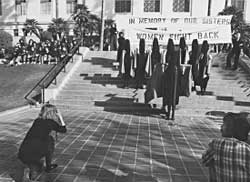Suzanne Lacy is an activist and performance artist whose work includes installations, videos and large-scale performances on social themes and urban issues. She often collaborates with other artists to produce works about women’s issues. Her first large-scale public work, Three Weeks in May (1977), dramatized the high incidence of rape in Los Angeles. One of her best-known works to date is The Crystal Quilt (Minneapolis, 1987) a performance which included 430 older women and aired live on PBS. She is currently the Chair of Fine Arts at the Otis College of Art and Design in Los Angeles.
Suzanne Lacy is one of the feminist cultural pioneers in Los Angeles who exposed the hidden themes of violence against women in mainstream culture during the 1970s. Leslie Labowitz is an artist who studied in Los Angeles and in Germany, where she developed her early activist performance work with other women artists. Lacy and Labowitz collaborated for several years after 1977 working on large-scale performances involving political lobbying, media intervention and grass roots organization around the issue of violence against women.
Suzanne Lacy, The Crystal Quilt (1987)In December 1977, the ‘Hillside Strangler’ was a news sensation in Los Angeles. But media coverage focused primarily on the randomness of the violence, and less on violence against women. In Mourning and in Rage was a media performance offering an alternative interpretation of the case-one that included a feminist analysis of violence. Participants from the Woman’s Building, the Rape Hotline Alliance and the City Council joined with the feminist community and victims’ families in creating a public ritual of rage and grief. The performance consisted of a sixty women following a hearse to City Hall, where news media reporters waited. Ten tall women wearing black mourning robes climbed from the hearse. At the front steps of City Hall, the performers each spoke of a different form of violence against women, connecting these as part of a fabric of social consent for such crimes.
In Mourning and in Rage brought women together to address the media's sensationalized coverage of a series of murders and, more generally, the spread of violence against women in American cities (Chadwick, 375). Lacy and Labowitz founded "Ariadne: A Social Network," an organization intended to bring together women in the arts, media, and government who were committed to feminist issues (Chadwick, 376).
Suzanne Lacy's work spoke for the victims of these vicious crimes. The performance was like an outlet for women. It brought attention to these social issues in an artistic way.
Work Cited
http://www.suzannelacy.com/1970sviolence_mourning.htm
http://www.jstor.org/discover/10.2307/3345993?uid=3739808&uid=2129&uid=2&uid=70&uid=4&uid=3739256&sid=21102888902907
http://lib.stanford.edu/women-art-revolution/bio-suzanne-lacy
http://www.suzannelacy.com/1970sviolence_mourning.htm
http://www.jstor.org/discover/10.2307/3345993?uid=3739808&uid=2129&uid=2&uid=70&uid=4&uid=3739256&sid=21102888902907
http://lib.stanford.edu/women-art-revolution/bio-suzanne-lacy



No comments:
Post a Comment